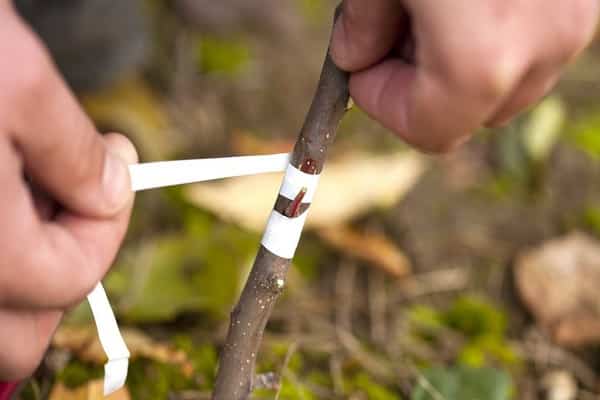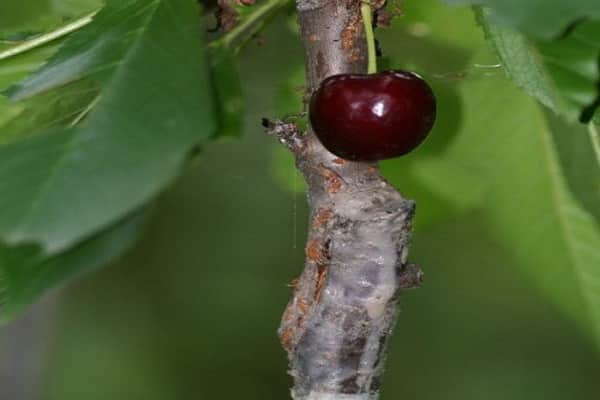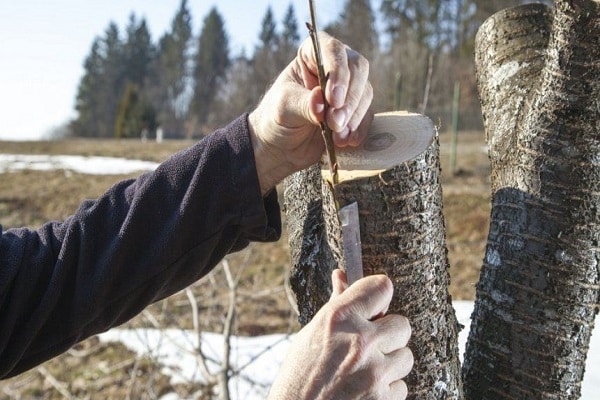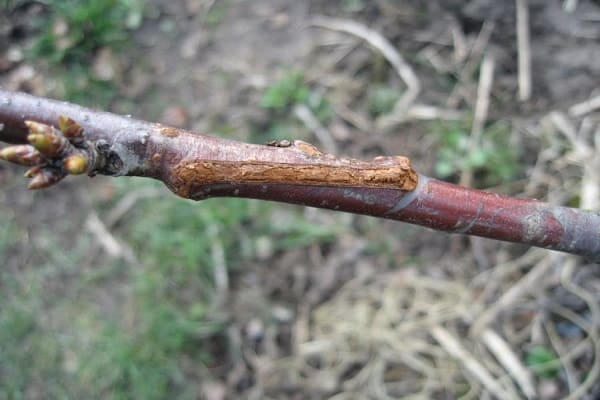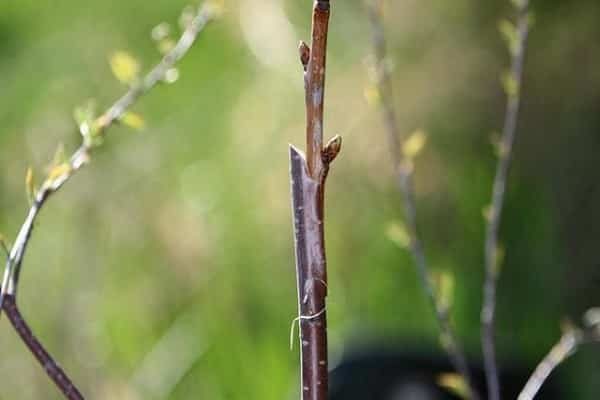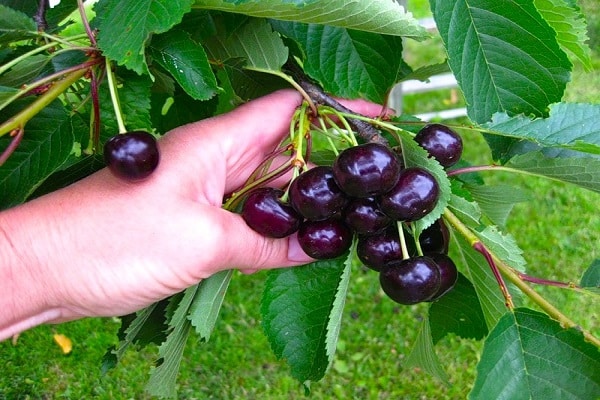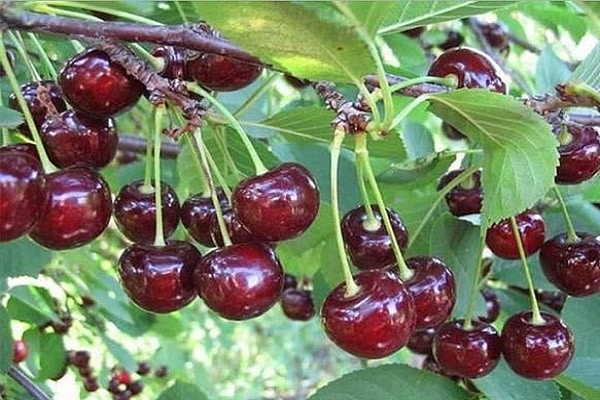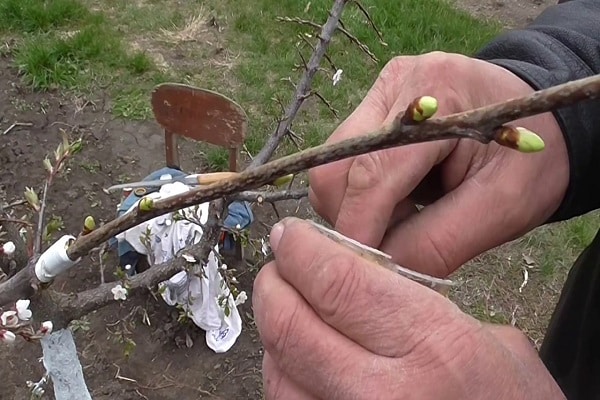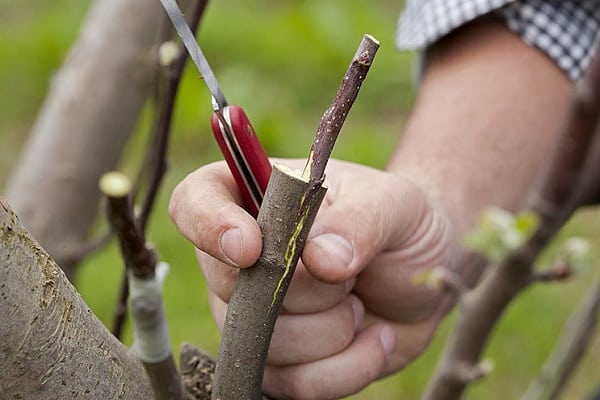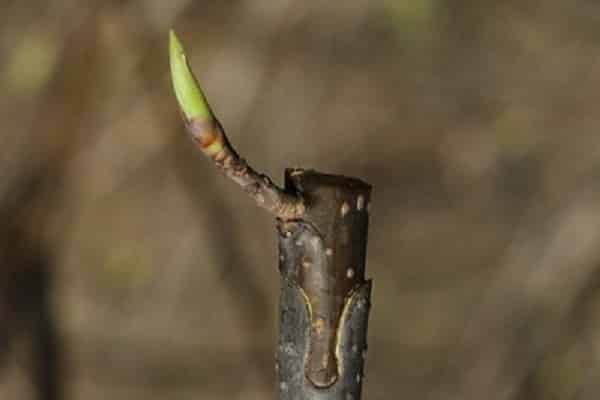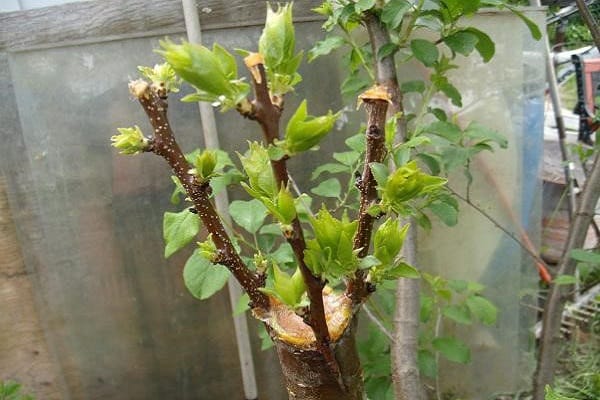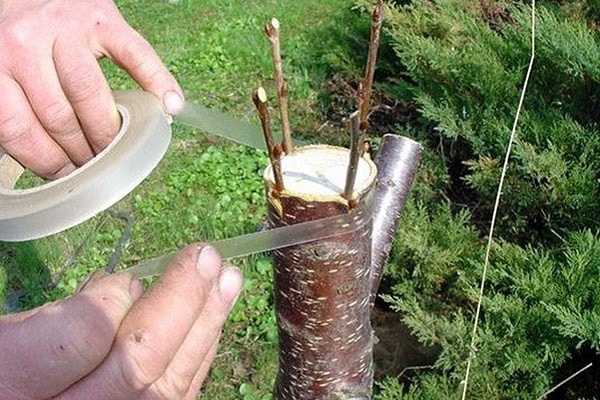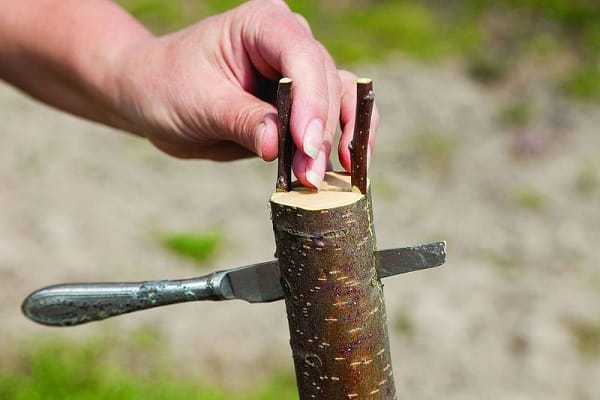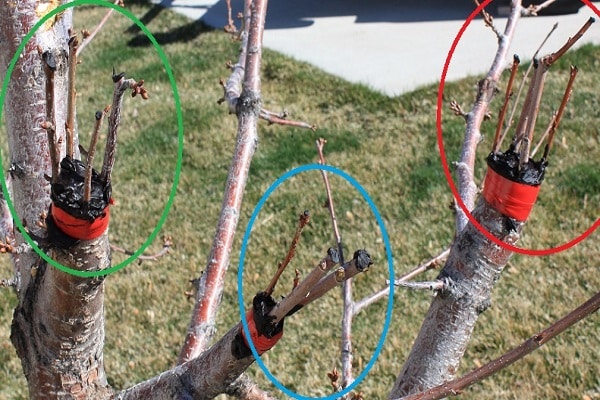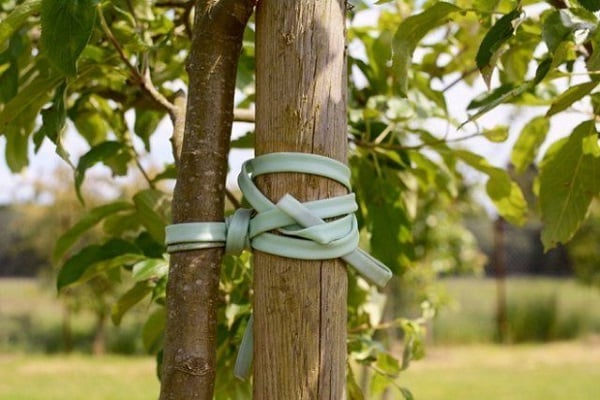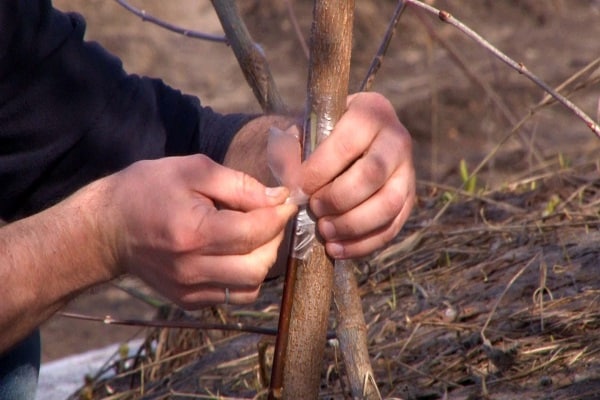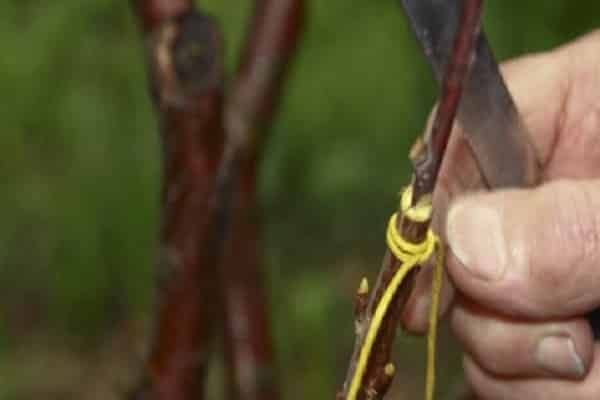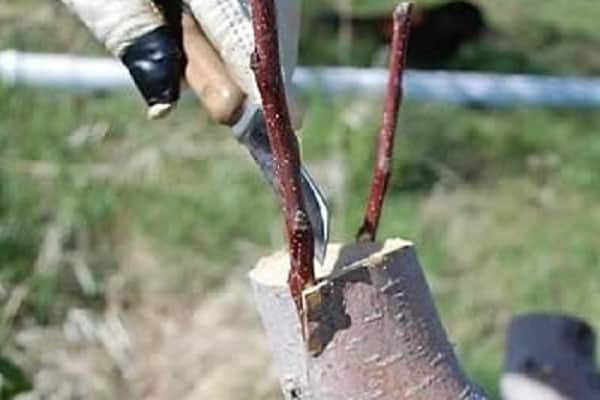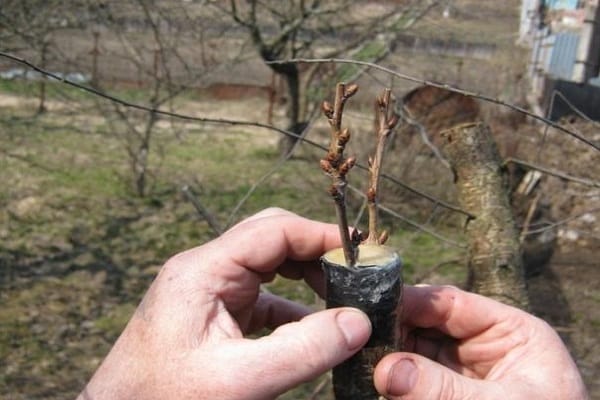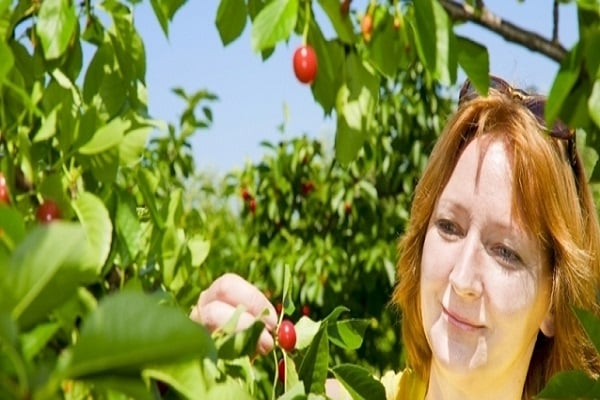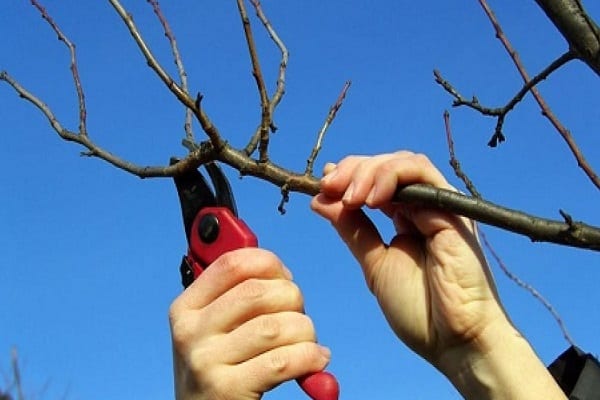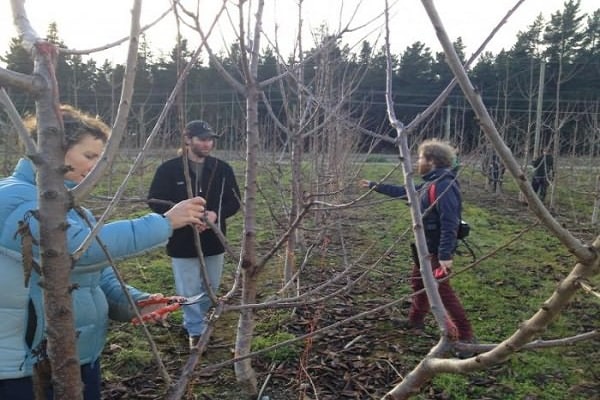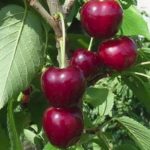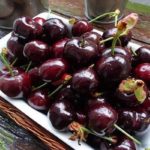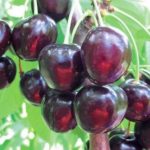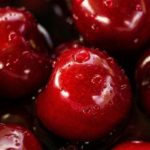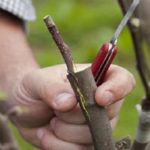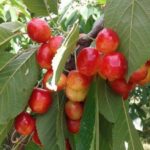Very often, summer residents complain that no matter how much they buy cherry seedlings, the trees grow poorly, the ovary falls off after flowering, they can’t taste the berries, but the plums and cherries that are cultivated in the same area give a good harvest. Cherry grafting helps improve resistance to frost and strengthen immunity to fungal and bacterial diseases. Not only this type of stone fruit crop is suitable as a rootstock, but also other plants from the Rosaceae family.
- Advantages of the method
- Deadlines
- in spring
- In summer
- in autumn
- What fruit trees can cherry trees be grafted onto?
- Procedure options
- Simple copulation
- Improved copulation
- Cortical method
- Into the cleft
- Half-split
- Bridge grafting
- Into the corner cut
- Into the side cut
- Cherry grafting technology
- Tree care after the procedure
Advantages of the method
Although the procedure in which petioles from one tree are fused to another seems complicated, it is accessible even to novice gardeners and gardeners. The advantages of vaccination include the possibility of:
- Get large fruits.
- Significantly increase productivity.
- Strengthen resistance to diseases and unfavorable natural environments.
2 trees take part in the process. The scion in the form of a bud or petiole is grafted onto the plant. It is usually cut from a fertile but old crop and combined with another tree - the rootstock.
Grafting helps improve the taste of berries and delay ripening. The procedure is resorted to when cherries, for unknown reasons, do not bear fruit for a long time; the variety is not suitable for the local climate.
On a grafted tree, fruits appear within two years, and on a new one, planted on the site of a cut down old one, no earlier than after 6 years.
Deadlines
The scion grows together well if the procedure is performed when the juice begins to secrete and the air is heated to at least 5 °C. Cuttings are cut in the fall, if the winter was not cold, the branches are engrafted in March.
in spring
Cherries can be grafted throughout the growing season; the main requirement is the absence of even slight frosts. At the end of April, and in the south at the beginning of March, cuttings are taken out of the cellar and soaked in the Kornevin preparation. They are fused with the rootstock using any of the following methods:
- copulations;
- into the cleft;
- into a corner cut;
- for the bark.
In the spring, for grafting, you can use not only cuttings prepared in the fall, but also those cut on the same day, but it is not always possible to get a positive result at this time.
In summer
They resort to grafting trees in July and August, but in the southern regions, and often in the middle zone, it is hot during this period; experienced gardeners recommend starting the procedure in early June, when the weather is comfortable.
in autumn
If for some reason you did not have time to graft the cherries in spring or summer, this can be done in September, in the south - in October. The graft will still have time to take root before the onset of cold weather.
What fruit trees can cherry trees be grafted onto?
Only cuttings of related garden crops are grown. A good rootstock for peach is apricot, and apple for pear. Sweet cherries are grafted onto sweet cherries when it is necessary to preserve the variety, increase the size of the berries, and add zest to the fruit.
In other cases, I use cherry plum, plum, and apricot for the rootstock. A closer relative of the sweet cherry is the sour cherry. The varieties that are best suited for grafting are:
- Vladimirskaya;
- Gisella;
- Pike;
- Magalebskaya;
- Griot Rossoshansky.
Shoots of bird cherry hybrids grow for a long time and poorly. It is difficult to plant cherries on plum trees, but some gardeners succeed.
Before you start grafting a fruit tree, you need to prepare your tools. Be sure to purchase a sharp knife, pruning shears, and a small hand saw. The shoots are fixed to the plant with electrical tape and tape.
Procedure options
Having decided which rootstock will be used for grafting next season, cuttings are prepared in November, when all the leaves have fallen from the trees. To do this, cut off annual shoots with a diameter of at least 50 mm with one growth bud and several lateral buds.
The branches prepared for grafting are taken to the cellar, where they are placed in soil made of sand, peat, and sawdust.If there is no basement, the cuttings are wrapped in a wet cloth, then in polyethylene and stored in the refrigerator.
Grafting of cherries with young green branches is carried out from summer to autumn; sometimes such shoots are used in the spring, but not always successfully.
Simple copulation
Even novice gardeners can master the method in which the rootstock has the same diameter as the grafted shoot. Select a smooth branch from the cherry tree and wipe it with a damp cloth. Using a sharp knife, make an even cut on it at an angle of 35 degrees.
The cutting is prepared from a fertile variety of stone fruit with 2 or 4 strong buds, 10 mm away from the lowest one, and the same operation is performed as on the rootstock. At a distance of 2 cm above the third bud, another cut is made, but even.
In order for the shoots to grow together correctly, you only need to use a sharp knife during work, otherwise their cambium will not match. The cuttings are carefully connected to the rootstock to create a straight and even branch.
A strip cut from polyethylene 1 cm wide is wrapped over the grafting site, making sure that the cuttings do not move even 1 mm, otherwise they will not be able to grow together. The top cut of the cherry is coated with varnish. This is done in order to prevent the cutting bud from dying.
Improved copulation
In order for the shoot to take root more quickly, the procedure must be performed very quickly, otherwise the tree will dry out when cut. Gardeners who have been grafting stone fruit crops for a long time are resorting to improved copulation. They split the cutting areas in the center into thirds, both on the rootstock and on the cuttings. The resulting tongues contribute to a tighter connection of both grafted parts.
Cortical method
Gardeners cut off the upper part of the rootstock with pruning shears; this is done if it is much thicker than the prepared cutting.At the beginning of the growing season, the wood is easily removed from the bark using a sharp knife, and the knots are cut off with a saw. After this, longitudinal cuts about 4 cm long are made on the rootstock and covered with polyethylene.
The cutting is applied to a puncture on the trunk of the plant and wrapped with tape or tape. The cherry cut is treated with a special varnish.
Many gardeners use this particular grafting method, since several shoots are grafted onto one rootstock, at least some of them still take root, and the plant is less injured.
Into the cleft
At the beginning of spring, when the buds have not yet blossomed and the stone fruit crops have not woken up from hibernation, they resort to a more complex technology that allows them to graft cherries:
- On a tree used as a rootstock, the branches are cut down, leaving only a few at the bottom, and the trunk is shortened to a height of 50 cm.
- Splits are made in the stump with a small ax and a prepared scion is inserted into each, the bottom of which is sharpened like a wedge and tied to the plant with tape..
- The sections, the thickness of which should not exceed 50 mm, are covered with garden pitch.
This method helps to renew old trees while preserving the cherry variety. Only thin branches are grafted. It is better to resort to the procedure in March, in early April.
Half-split
With this technology, the cherry is almost not damaged, only a small part on the side is affected. To graft a cutting:
- The ax blade is inserted into the stump 30 mm deep, without reaching the opposite end, and a split is made.
- The lower edge of the shoot is cut off so that it looks like a wedge.
- Wrap in polyethylene in 3 layers.
The scion is tied with twine. With this method, you don’t even need a garden varnish.
Bridge grafting
It happens that in winter, hares in search of food get to the garden and gnaw the bark.To close the wounds in the trunk and renew the cherry, they resort to bridge grafting technology. It is better to do this when the juice begins to flow out.
The cuttings are inserted so that one end is above the damage and the other above it. The shoots are placed in several places and cuts are made in the bark. The scion is fixed to the tree with film and wrapped in burlap. The edges of the joint are treated with garden varnish. With this grafting technology, not a single bud is left on the cuttings.
Into the corner cut
If the branches used for the scion have a diameter of no more than 20 mm, slightly retreating from the edge of the stump, use a knife to cut to a depth of 6 mm. Parallel to the first, in the opposite direction, at the same angle of 30°, a second cut is made. The lower end of the cutting is ground off on both sides so that it fits easily but tightly into the rootstock.
Into the side cut
This grafting technology can be done by experienced gardeners, since any operation with a knife and pruning shears must be performed very accurately.
First, an incision is made 20 cm from the base of the cutting so that one side is 10 mm shorter than the other. The shoot is shaped into a wedge, secured with plastic wrap, and inserted into a cut on the rootstock.
When grafting a cutting onto an old plant with thick bark, the indentations are made not at an angle, but directly, where the branch is secured, grinding it down diagonally to form a blade.
Cherry grafting technology
If you grow stone fruit crops on a suburban plot or in your yard and want to increase the area planted with fruit trees, you need to take into account that Cherries do not reproduce from seeds, but with the help of vaccination.
In order for the escape to take root correctly and quickly:
- For the rootstock, choose a healthy stone fruit that produces a stable harvest.
- A large number of cuttings of different types and ripening periods are not added to the tree.
- For grafting, take strong branches that are located closer to the trunk.
- The binding is removed after the bark has formed at the junction of the shoot.
In the first year, the flowers on the grafted cherry are picked and the emerging ovary is removed. If this is not done, the tree will grow and develop poorly. Experienced gardeners recommend using cherries and cherry plums as rootstocks, which are well adapted to the local climate. After 4 years, an established cutting can be used for work again.
In the spring, any of the methods is suitable for grafting, from simple copulation to the most complex technology; you can take both pre-prepared shoots and green branches.
To change the cherry variety, start re-grafting. This procedure is in demand when the planted plant turns out to be unproductive; small and tasteless berries ripen on it.
Cherries up to 10 years old are used as a rootstock. The process is started in the spring, when frost is no longer expected. Re-grafting with a bud or eye can be done even at the end of summer and is quite effective.
Tree care after the procedure
If the cherry grafting is done correctly, after just a few weeks, fresh shoots begin to appear from the petiole buds, which merge with the rootstock. You need to make sure that the young bark on the tree is not chewed by hares. To do this, the trunk and lower branches are wrapped in thick fabric or pine needles for the winter.
After vaccination, it is necessary to carry out preventive measures to prevent the invasion of aphids and the appearance of other insects that feed on the sap of the leaves.Trees are sprayed with insecticides every 3 weeks; the preparations “Biotlin” and “Tanrek” are successfully used.
The shoot does not take root if the cherry tree does not have enough nutrition. Branches and twigs that grow on the rootstock below the grafted shoot must be cut off. If the bark is split during the procedure, the damaged areas and wounds are treated with garden pitch.
It is necessary to monitor the soil moisture in the tree trunk circle. After watering, the soil should be wet by at least 30 cm.
To prevent the scion from being broken by the wind or bent by birds, a splint must be applied to it 2 months after grafting. They make it from rowan branches and tie it to a support and a tree..
In August, the top of the scion is pinched. Next spring, young shoots are pruned to form a crown, and after 2 years they are shortened by half a meter, branches that grow inside the trunk are removed.
After grafting cherry:
- Gains resistance to adverse climate conditions.
- Gives a high yield.
- Pleases with larger and tastier berries.
To obtain such a result, it is necessary to adhere to the timing of the procedure, and do not forget about the characteristics of each plant.
To replant a cherry after grafting, it is dug up along with a lump of earth. A hole 70 cm deep and wide is prepared in the fall, filled with peat, humus, and fertilizer. The roots are carefully laid, the neck of the plant is left 8 centimeters above the soil surface. The soil is compacted and watered abundantly, and the branches are shortened slightly. The cherry is tied to a peg on both sides.

